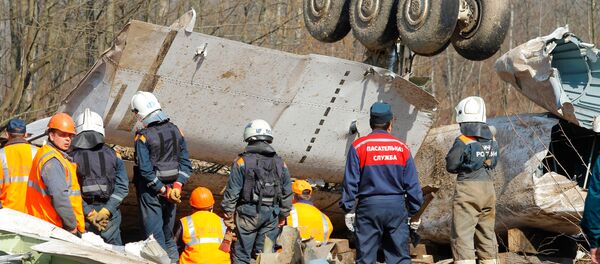MOSCOW (Sputnik) – On April 10, 2010, the Polish presidential Tu-154M, on its way to Russia to mark the 70th anniversary of the Katyn massacre, the mass execution of Polish officers by the Soviet NKVD during WWII, crashed outside Smolensk, western Russia, killing all 96 passengers and crew onboard. Investigators concluded that pilot error and poor weather conditions were to blame for the disaster.
"According to the … final report, the results of ballistic and explosive tests … were analyzed during the work of the technical commission. No signs of impact of explosives on the plane were detected," Morozov said.
According to Morozov, there was no disappearance of on the recording made by flight recorders of the plane of then-Polish President Lech Kaczynski which crashed in 2010, as claimed by Polish experts.
Morozov stated that a quick access recorder and a flight recorder were installed on the plane.
"The decoding of the Polish ATM-QAR recorder took place in Poland. It was established that the recording on it ended 2.5 seconds before that on the flight recorder (the Polish recorder was not an accident data recorder, so to say, protected, so after being significantly damaged unreliability or lack of information on it is quite understandable.)Maybe this is the source of information on some ‘missing’ three seconds," Morozov said.
Morozov added that the Interstate Aviation Committee had provided a full transcript of the recording made by the flight recorder.
"No five seconds from this recording ‘disappeared.’ It is possible to familiarize oneself with the full recording, including the allegedly missing seconds, by looking at the Interstate Aviation Committee report online both in Russian and in English. Five seconds is approximately the time which lapsed from the moment of the collision of the plane with the tree which led to its intensive destruction, until the recording ended," he explained.
The crew of the aircraft of then-Polish President Lech Kaczynski that crashed near Russia's western city of Smolensk in 2010 was made aware that weather conditions were not appropriate for landing, Alexei Morozov told Sputnik in an interview.
"The crew had been informed that weather conditions at the airdrome were not appropriate for landing. The captains of foreign aircraft take decisions on the possibility to land on their own, assuming full responsibility for the made decision," Morozov said.
In 2011, the IAC published a final report on the results of the technical investigation into the accident. The report gave the crew's decision not to route the plane to an alternative aerodrome as the direct cause of the crash. The report also outlined serious deficiencies in the way the aircraft's crew was trained and how readiness for the flight was assessed.
In September 2016, the new Polish commission investigating the crash near Smolensk voiced the first results of the inquiry. The experts said that the plane started to disintegrate in the air at a distance of 900 meters (984 yards) from the crash site and there were no final seconds of records at the recording devices.
The commission stated that it had succeeded to get access to the full versions of records showing that generator, engine and devices responsible for altimetry broke shortly before the crash. Polish Defense Minister Antoni Macierewicz made a decision to declassify the documents related to the crash.
In April 2017, the Polish commission released new results of its activities. The body put the blame for the crash on Russia's air traffic control officers. The revealed materials also stated that there was an explosion aboard the plane before it had collided with the ground.
Kremlin spokesman Dmitry Peskov said that Moscow could not agree with Poland's accusations toward Russian air traffic controllers and Russia would continue to carry out investigation. The IAC refuted the findings of the Polish commission, as the technical commission had not found out any impact of explosive materials on the aircraft. The IAC also refuted the statements about the seconds that had allegedly disappeared from the record.





